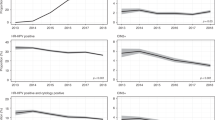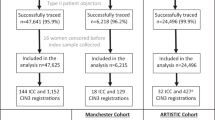Abstract
To identify the risk factors for cervical intraepithelial neoplasia (CIN), we reanalysed the data from our previous case–control study by adjusting for human papillomavirus (HPV) antibodies. Unlike our previous study based only on HPV DNA, smoking and Chlamydia trachomatis infection were revealed as significant risk factors for CIN after adjustment for HPV antibodies.
Similar content being viewed by others
Main
Infections by oncogenic human papillomaviruses (HPVs) are established as a major risk factor for cervical intraepithelial neoplasia (CIN) and invasive cervical cancer (ICC). However, only a fraction of infected women develop cervical cancer, suggesting the involvement of additional cofactors in cervical carcinogenesis. In numerous case–control studies various epidemiological factors have been suggested as relevant to CIN and ICC, although the results from these studies have not been entirely consistent (Schiffman and Brinton, 1995). In epidemiological studies of risk factors for CIN and ICC, it is of great importance to allow for the strong effect of HPV infections. To determine HPV exposure among cases and controls, most studies have used HPV DNA testing, while recent studies have employed HPV capsid serology. However, it has not been determined whether the different measurements of HPV exposure can affect conclusions from case–control studies.
To address this issue, we reanalysed the data from our previous case–control study of CIN by adjusting for HPV DNA and antibodies.
Materials and methods
The present study was conducted on women who previously participated in a Japanese case–control study of CIN. The details about this case–control study have been provided elsewhere (Yoshikawa et al, 1999). Among a total of 167 pairs, serum samples from 26 cases and 58 controls were not available for HPV capsid serology. Therefore, the present analysis was restricted to 250 subjects consisting of 141 cases (80 CIN I, 34 CIN II and 27 CIN III) and 109 controls that were tested for both cervical HPV DNA and serum HPV antibodies. The distributions of study variables in the excluded/included cases and controls were similar. We examined HPV DNA in cervical samples by polymerase chain reaction (PCR) using consensus primers for the HPV L1 region (Yoshikawa et al, 1999). Detection of IgG antibodies to HPV16, 52 and 58, the most frequently detected HPV types in Japan, was performed by enzyme-linked immunosorbent assay (ELISA) using purified L1-capsids (virus-like particles (VLPs)) as antigens (Matsumoto et al, 2003). In addition, the level of IgG antibodies to Chlamydia trachomatis was determined by using an enzyme immunoassay (EIA) kit (Thermo Labsystems, Vantaa, Finland) that does not detect antibody to Chlamydia pneumoniae. The adjusted odds ratios (ORs) and 95% confidence intervals (CIs) were estimated by a logistic regression analysis. The analysis was carried out using JMP 4.0J statistics package (SAS Institute, Cary, NC, USA). The P-values obtained in all tests were considered significant at <0.05.
Results
Human papillomavirus status among cases and controls was determined by using HPV DNA testing and HPV capsid serology (Table 1). We reconfirmed that HPV DNA positivity and HPV seropositivity were strongly associated with CIN development (P<0.0001 and =0.0002, respectively), although the relative risk for CIN was considerably different between HPV DNA positive and seropositive women (17.9 and 2.7, respectively) (Table 2). The estimated risks for CIN development in relation to various epidemiological factors are shown in Table 3. In the present study, the adjusted analysis for HPV DNA alone gave the same results as our previous study (Yoshikawa et al, 1999). Marriage, multiparity and age at first pregnancy were found to be significant risk factors for CIN development in the crude and adjusted analyses. Sexual behaviour, including age at first intercourse and lifetime number of sexual partners, was significantly associated with an increased risk of CIN in the crude analysis, but the significance disappeared in both adjusted analyses. Current smoking and C. trachomatis infection were revealed as significant cofactors for CIN development after adjusting for HPV antibodies, although not after adjusting for HPV DNA. We found no association between the use of oral contraceptives (OC) and CIN development because of the low prevalence of OC users among study subjects. The effect of smoking on CIN development did not appear to vary between HPV-positive and HPV-negative subjects, while the effect of C. trachomatis infection was stronger among the former.
Discussion
With regard to smoking and C. trachomatis infection, the analysis adjusted for HPV antibodies gave different results from the analysis adjusted for HPV DNA. One explanation for this difference is that the antibody adjustment may reflect residual confounding by HPV, since only 54% of CIN cases were seropositive for HPV16/52/58 due to the limited sensitivity and high type-specificity of HPV capsid serology (Matsumoto et al, 2003). Another reasonable explanation is that smoking and C. trachomatis infection may be significant cofactors associated with persistent HPV infections. In controls, HPV DNA positivity was much lower than seropositivity (15 vs 30%, respectively). Since HPV DNA testing at a single time point cannot identify past infections, the analysis based on HPV DNA may miss cofactors determining whether HPV infection is cleared or becomes persistent. In fact, a very recent study reported that smoking is associated with a reduced probability of clearing oncogenic HPV infections (Giuliano et al, 2002). Associations of smoking and C. trachomatis infection with persistent HPV infections may be supported by several studies suggesting the modulation of host immunity by smoking (Barton et al, 1988) and chlamydial infection (Zhong et al, 1999).
Although the DNA adjustment enhanced the CIN risk among current smokers as well as the antibody adjustment, the association of smoking with an increased risk of CIN was not statistically significant in the DNA-based analysis. This may be due to the small numbers in the statistical analysis.
Unlike our previous study based on HPV DNA (Yoshikawa et al, 1999), the present study has shown that smoking and C. trachomatis infection are significant cofactors for CIN development after adjustment for HPV antibodies. Simi-larly, associations of smoking and C. trachomatis infection with cervical neoplasia have been consistent in case–control studies employing HPV capsid serology (Dillner et al, 1997; Olsen et al, 1998; Kjellberg et al, 2000; Koskela et al, 2000; Anttila et al, 2002), but inconsistent in HPV DNA-based studies (Schiffman et al, 1993; de Sanjosé et al, 1994; Eluf-Neto et al, 1994; Olsen et al, 1995; Ferrera et al, 1997). Our observation suggests that epidemiological studies relying on a single assessment of HPV status should be interpreted with caution. To fully evaluate the role of epidemiological cofactors in HPV-related carcinogenesis, allowance for both HPV DNA and antibodies may be necessary.
Change history
16 November 2011
This paper was modified 12 months after initial publication to switch to Creative Commons licence terms, as noted at publication
References
Anttila T, Saikku P, Koskela P, Bloigu A, Dillner J, Ikäheimo I, Jellum E, Lehtinen M, Lenner P, Hakulinen T, Närvänen A, Pukkala E, Thoresen S, Youngman L, Paavonen J (2002) Serotypes of Chlamydia trachomatis and risk for development of cervical squamous cell carcinoma. JAMA 285: 47–51
Barton SE, Maddox PH, Jenkins D, Edwards R, Cuzick J, Singer A (1988) Effect of cigarette smoking on cervical epithelial immunity: a mechanism for neoplastic change? Lancet (8612): 652–654
de Sanjosé S, Muñoz N, Bosch FX, Reimann K, Pedersen NS, Orfila J, Ascunce N, González LC, Tafur L, Gili M, Lette I, Viladiu P, Tormo MJ, Moreo P, Shah K, Wahren B (1994) Sexually transmitted agents and cervical neoplasia in Colombia and Spain. Int J Cancer 56: 358–363
Dillner J, Lehtinen M, Björge T, Luostarinen T, Youngman L, Jellum E, Koskela P, Gislefoss RE, Hallmans G, Paavonen J, Sapp M, Schiller JT, Hakulinen T, Thoresen S, Hakama M (1997) Prospective seroepidemiologic study of human papillomavirus infection as a risk factor for invasive cervical cancer. J Natl Cancer Inst 89: 1293–1299
Eluf-Neto J, Booth M, Muñoz N, Bosch FX, Meijer CJLM, Walboomers JMM (1994) Human papillomavirus and invasive cervical cancer in Brazil. Br J Cancer 69: 114–119
Ferrera A, Baay MFD, Herbrink P, Figueroa M, Velema JP, Melchers WJG (1997) A sero-epidemiological study of the relationship between sexually transmitted agents and cervical cancer in Honduras. Int J Cancer 73: 781–785
Giuliano AR, Sedjo RL, Roe DJ, Harris R, Baldwin S, Papenfuss MR, Abrahamsen M, Inserra P (2002) Clearance of oncogenic human papillomavirus (HPV) infection: effect of smoking (United States). Cancer Causes Control 13: 839–846
Kjellberg L, Hallmans G, Åhren AM, Johansson R, Bergman F, Wadell G, Ångström T, Dillner J (2000) Smoking, diet, pregnancy and oral contraceptive use as risk factors for cervical intra-epithelial neoplasia in relation to human papillomavirus infection. Br J Cancer 82: 1332–1338
Koskela P, Anttila T, Bjørge T, Brunsvig A, Dillner J, Hakama M, Hakulinen T, Jellum E, Lehtinen M, Lenner P, Luostarinen T, Pukkala E, Saikku P, Thoresen S, Youngman L, Paavonen J (2000) Chlamydia trachomatis infection as a risk factor for invasive cervical cancer. Int J Cancer 85: 35–39
Matsumoto K, Yoshikawa H, Yasugi T, Nakagawa S, Kawana K, Takeoka A, Yaegashi N, Iwasaka T, Kanazawa K, Taketani Y, Kanda T (2003) IgG antibodies to human papillomavirus 16, 52, 58 and 6 L1 capsids: case–control study of cervical intraepithelial neoplasia in Japan. J Med Virol 69: 441–446
Olsen AO, Dillner J, Skrondal A, Magnus P (1998) Combined effect of smoking and human papillomavirus type 16 infection in cervical carcinogenesis. Epidemiology 9: 346–349
Olsen AO, Gjøen K, Sauer T, Ørstavik I, Naess O, Kierulf K, Sponland G, Magnus P (1995) Human papillomavirus and cervical intraepithelial neoplasia grade II–III: a population-based case–control study. Int J Cancer 61: 312–315
Schiffman MH, Bauer HM, Hoover RN, Glass AG, Cadell DM, Rush BB, Scott DR, Sherman ME, Kurman RJ, Wacholder S, Stanton CK, Manos MM (1993) Epidemiological evidence showing that human papillomavirus infection causes most cervical intraepithelial neoplasia. J Natl Cancer Inst 85: 958–964
Schiffman MH, Brinton LA (1995) The epidemiology of cervical carcinogenesis. Cancer 76: 1888–1901
Yoshikawa H, Nagata C, Noda K, Nozawa S, Yajima A, Sekiya S, Sugimori H, Hirai Y, Kanazawa K, Sugase M, Shimizu H, Kawana T (1999) Human papillomavirus infection and other risk factors for cervical intraepithelial neoplasia in Japan. Br J Cancer 80: 621–624
Zhong G, Fan T, Liu L (1999) Chlamydia inhibits interferon γ-inducible major histocompatiblity complex class II expression by degradation of upstream stimulatory factor 1. J Exp Med 189: 1931–1937
Acknowledgements
We thank Graham R Leggatt for helpful discussion, and Mami Kimura and Sumiko Mitsumata for assistance. We are also grateful to all the women that participated in this study. This work was supported by grants from the Ministry of Education, Science, Sports and Culture of Japan.
Author information
Authors and Affiliations
Corresponding author
Rights and permissions
From twelve months after its original publication, this work is licensed under the Creative Commons Attribution-NonCommercial-Share Alike 3.0 Unported License. To view a copy of this license, visit http://creativecommons.org/licenses/by-nc-sa/3.0/
About this article
Cite this article
Matsumoto, K., Yasugi, T., Oki, A. et al. Are smoking and chlamydial infection risk factors for CIN? Different results after adjustment for HPV DNA and antibodies. Br J Cancer 89, 831–833 (2003). https://doi.org/10.1038/sj.bjc.6601220
Received:
Revised:
Accepted:
Published:
Issue Date:
DOI: https://doi.org/10.1038/sj.bjc.6601220
Keywords
This article is cited by
-
Chlamydia trachomatis infection: implications for HPV status and cervical cancer
Archives of Gynecology and Obstetrics (2014)



